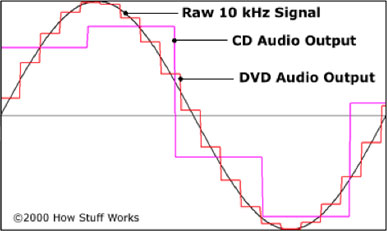The Medium - Encoding and Decoding
The process of encoding and decoding a message can be described in five sequential states (SEMDR). Encoding starts when the sender (S) encodes (E) a message into/onto a medium (M). Then the message is sent to and received where it’s decoded (D) by the receiver (R).
SEMDR
- Sender
- Encode
- Medium (sometimes referred to as the Message)
- Decode
- Receiver
Medium, the object (both literal and figurative) that contains or transmits a message or information. A transmission medium can be classified as a: Linear medium, if different waves at any particular point in the medium can be added; Bounded medium, if it is finite in extent, otherwise unbounded medium; Uniform medium, if its physical properties are unchanged at different points; Isotropic medium, if its physical properties are the same in different directions. For the purposes of this site the two terms are interchangeable. (see link to Wikipedia to the right)
Analog vs. Digital
An analog recording is a mechanical representation of the original sound. An example of this is the vinyl record and record player. The grooves on the record represent an exact replica of the sound that was recorded – this includes any imperfections in both the original sound and the recording surface. One of the main traits of an analog recording is that the signal is continuous. This trait is what differentiates an analog signal from a digital signal. Recording the original sound as a piece of digital information produces a digital recording. This form of recording is discrete and depending on how high the bit rate is, it will sometimes not include all of the original sound. See the “Further Fact” at the bottom of this page for more information.
Transmission Models
One of the benefits of digital media is that the media can be transferred multiple times without suffering from degradation. Examples of transmission models include Air, Satellite, Cable and Networks.
Radio and TV have a fixed method of transmitting information and people have a fixed method of receiving the transmission. This is different that the Internet. With Internet transmissions its harder to understand who is looking or receiving the content.
Technology Fact – The Difference between bits and bytes
The word "bit" is an acronym, short for Binary digit. A "bit" by definition is the smallest unit of data that a computer can recognize. A “byte” is a group of 8 bits – and one byte is the equivalent of one character (like the character “r” for example).
Further Fact - Analog vs. Digital sound (is vinyl better than a cd?)
CD’s and DVD’s only capture snapshots of the sound. They’re not capturing the complete (original) sound. Some sounds that have very quick transitions, like drum beats or a trumpet’s tone, will sometimes be distorted because of that quick change. The rate at which the original sound is sampled is fixed. A vinyl record has a groove carved into it that mirrors the original sound’s waveform. This means that that there is no loss of information. The output from the record player is analog and the signal can be sent to the amplifier with no conversion. This means that the waveforms from a vinyl recording can be much more accurate, and that accuracy can be heard in the richness of the sound (by some). But there’s a downside, any specks of dust or damage to the disc can be heard as noise or static. During quiet spots in songs this noise may be heard over the music. Digital recordings don't degrade over time, and if the digital recording contains silence, then there will be no noise. See the diagram below.

 one
example of a transmission medium
one
example of a transmission medium